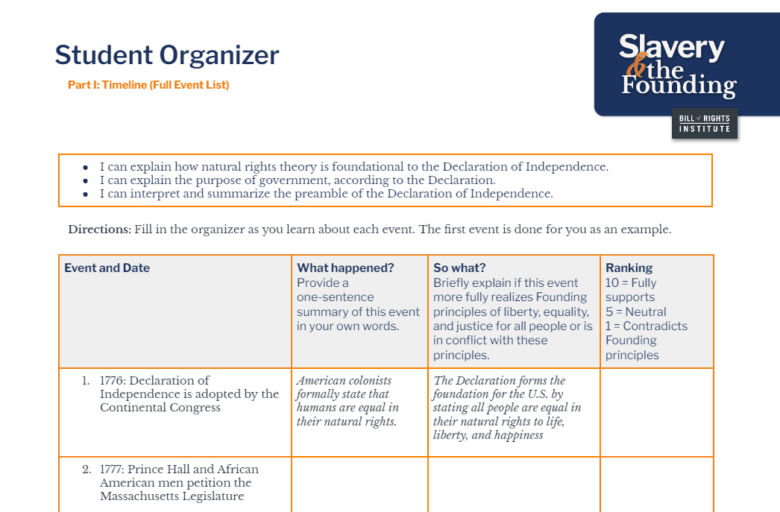Student Organizer: Event Cards
Abbreviated Student Organizer File Available Here
- I can explain how natural rights theory is foundational to the Declaration of Independence.
- I can explain the purpose of government, according to the Declaration.
- I can interpret and summarize the preamble of the Declaration of Independence.
Part I: Timeline
Directions: Fill in the organizer as you learn about each event. The first event is done for you as an example.
| Event and Date | What happened? Provide a one-sentence summary of this event in your own words. | So what? Briefly explain if this event more fully realizes Founding principles of liberty, equality, and justice for all people or is in conflict with these principles. | Ranking 10=Fully supports 5=Neutral 1=Contradicts Founding principles |
| 1776: Declaration of Independence is adopted by the Continental Congress | American colonists formally state that humans are equal in their natural rights. | The Declaration forms the foundation for the U.S. by stating all people are equal in their natural rights to life, liberty, and happiness. | |
| 1777: Prince Hall and African American men petition the Massachusetts Legislature | |||
| 1777: Vermont Constitution bans slavery | |||
| 1780: Constitution of Massachusetts claims all men are born free and equal | |||
| 1781: Elizabeth (Mumbet) Freeman successfully sues for her freedom | |||
| 1782: Virginia allows manumission by law | |||
| 1783: Quock Walker successfully sues for his freedom | |||
| 1783: Belinda Sutton petitions Massachusetts for an income from her former slaveholder’s estate | |||
| 1783: Virginia passes law emancipating slaves who served as soldiers in the Revolutionary War | |||
| 1784: Land Ordinance proposes to outlaw slavery | |||
| 1784: Rhode Island and Connecticut pass gradual emancipation plans | |||
| 1787: US Constitution is signed by 38 of the 41 delegates attending the Constitutional Convention | |||
| 1787: The Northwest Ordinance is passed by the Confederation Congress banning slavery | |||
| 1789-1815: French Revolution grapples with slavery | |||
| 1790: The Southwest Ordinance is passed by the first Congress | |||
| 1791-1804: Haitian Revolution begins as a slave revolt and creates a republic that outlaws slavery | |||
| 1793: Invention of the cotton gin | |||
| 1793: The first Fugitive Slave Law is passed by Congress | |||
| 1796: Tennessee enters the Union as a slave state | |||
| 1799: New York passes gradual emancipation plan | |||
| 1800: Gabriel’s Revolution | |||
| 1801: Georgia outlaws manumission | |||
| 1803: Louisiana Purchase | |||
| 1804: New Jersey passes gradual emancipation plan | |||
| 1808: The international slave trade is abolished by an act of Congress |
Part II: Connecting Events to Founding Principles
Directions: Plot each event on the graph below. Based on what you wrote in the “So what?” column, assign each event a value on the Y axis to the extent that it supports or contradicts the Founding principles of liberty, equality, and justice. Two events have already been done for you as an example.

Part III: Assess and Reflect
Now that you have considered major events related to slavery in the Founding era, write a response to the following questions:
- To what extent did events during and following the Revolutionary War confront the conflict between slavery and Founding principles of liberty, equality, and justice?
- How did the actions of individuals and groups during this time period work in concert with or against Founding ideals?
Your response should reference specific evidence from your organizer as well as your own analysis.



